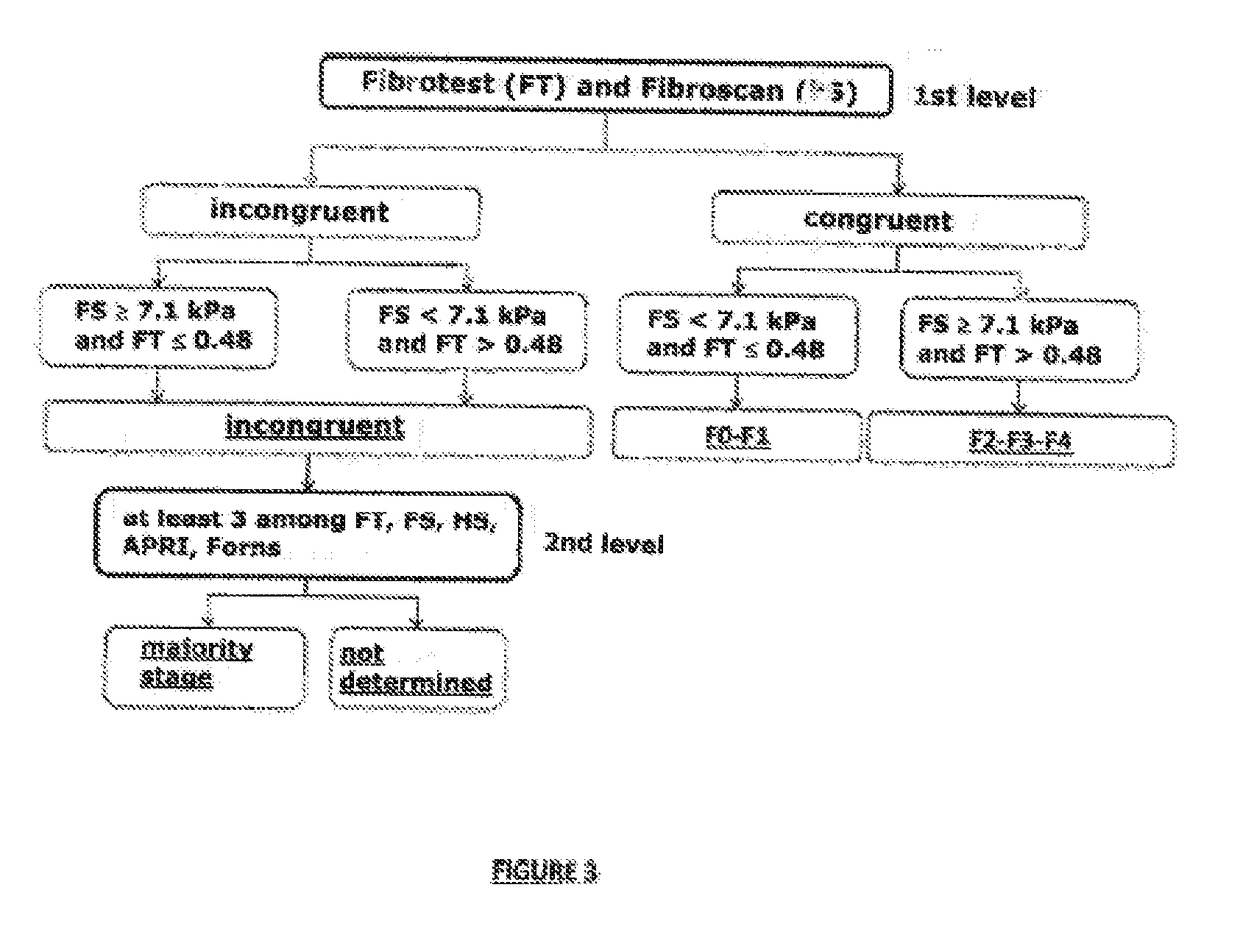Synergistic combination of biomarkers for detecting and assessing hepatic fibrosis
a biomarker and fibrosis technology, applied in the field of hepatic fibroses, can solve the problems of high cost, unfavorable treatment, and patients' major side effects, and achieve the effect of high serum concentration
- Summary
- Abstract
- Description
- Claims
- Application Information
AI Technical Summary
Benefits of technology
Problems solved by technology
Method used
Image
Examples
example 1
tion and Application of HA+CXCL10 Combinations to a Population of Patients Whose Degree of Fibrosis is Determined by Hepatic Biopsy Puncture (PBH)
[0765]The population of patients consisted of patients of the hospital Beaujon (100, boulevard du Général Leclerc; 92110 Clichy; France), who showed a chronic hepatitis as a result of infection by hepatitis C virus (HCV), covering all, or the majority, of the HCV genotypes.
[0766]The hepatic fibrosis score of these patients was determined by hepatic biopsy puncture (PBH). This population consisted of 118 patients, among whom 73 showed a fibrosis score F1, and 45 showed a fibrosis score F2 (score determined by PBH according to the Metavir F scores system, two independent readings by an approved pathologist). The studies performed were approved by the local ethics committee in accordance with the Helsinki declaration. All the patients gave their written informed consent.
[0767]The characteristics of these 118 patients are presented in Table 1 ...
example 2
n with Non-Invasive Tests Available to the Public (Same Population of Patients as in Example 1)
[0796]The 118 patients of Example 1 were tested for comparison with tests of measuring the stage of hepatic fibrosis that are additionally available to the public (tests that are commercially available or described in scientific articles).
[0797]Five tests were performed: the test HEPASCORE™, the test FIBROTEST™, the test APRI, the test FORNS and the test SHASTA.
[0798]The test HEPASCORE™ is commercialized by QUEST DIAGNOSTICS (3 Giralda Farms, Madison, N.J. 07940, USA), and is described in Adams et al. 2005.
[0799]The test FIBROTEST™ is commercialized by BIOPREDICTIVE (40, rue du Bac, 75007 Paris, France), and is described in Imbert-Bismut et al. 2001.
[0800]The test APRI is described in Wai et al. 2003.
[0801]The test FORNS is described in Forns et al. 2002.
[0802]The test SHASTA is described in Kelleher et al. 2005.
[0803]The one of these tests that is most often used currently is the test FIB...
example 3
tion and Application of HA+CXCL10 Combinations to a Population of Patients Independent of that of Example 1
[0816]A population of patients independent of that of Example 1 was created. This independent population consisted of 310 patients of the hospital Haut-Levêque (1, avenue Magellan; 33600 Pessac; France) showing a chronic hepatitis as a result of an infection with the hepatitis C virus (HCV), and covering all, or the majority, of the HCV genotypes.
[0817]The studies performed were approved by the local ethics committee in accordance with the Helsinki declaration. All the patients gave their written informed consent.
[0818]Since hepatic biopsy puncture (PBH) is virtually no longer used currently, the stage of fibrosis has been determined by using a combination of non-invasive tests based on different principles (blood tests and imaging), as recommended by the scientific community (cf. Castera 2012).
[0819]For this purpose, a modification of the algorithm of multivariate classificati...
PUM
 Login to View More
Login to View More Abstract
Description
Claims
Application Information
 Login to View More
Login to View More - R&D
- Intellectual Property
- Life Sciences
- Materials
- Tech Scout
- Unparalleled Data Quality
- Higher Quality Content
- 60% Fewer Hallucinations
Browse by: Latest US Patents, China's latest patents, Technical Efficacy Thesaurus, Application Domain, Technology Topic, Popular Technical Reports.
© 2025 PatSnap. All rights reserved.Legal|Privacy policy|Modern Slavery Act Transparency Statement|Sitemap|About US| Contact US: help@patsnap.com



